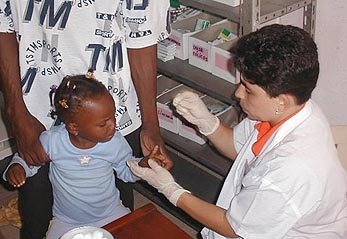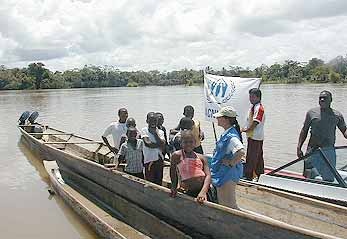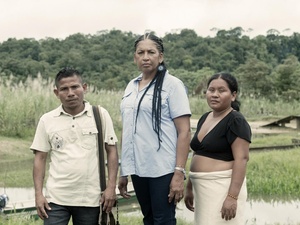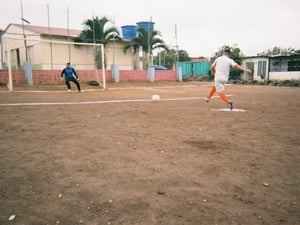Feature: Displaced Colombians reclaim their identity
Feature: Displaced Colombians reclaim their identity

UNHCR's mobile unit travels to a settlement of internally displaced Colombians in Medellín to help them request identification documents, known as cedula.
MEDELLÍN, Colombia (UNHCR) - The bright white vehicle, resembling a large camping car emblazoned with the UNHCR logo, is a startling sight as it lurches up the steep and narrow road winding through tumbledown shacks, patched together out of pieces of metal and scraps of wood. The sun is brutally hot and reflects off the metal roofs of the huts clinging to the hillsides at the highest point of the mountain.
From here, there is a magnificent view of Medellín, Colombia's second-largest city with a population of about 2 million. Set in a long valley, in a plateau surrounded by green mountains, the city centre's skyscrapers contrast with the shantytowns perched on the sides of the mountains. The marginalised hillsides are where most of the violence between Colombia's various armed groups in Medellín takes place and where most of the displaced people live.
Children run up behind the huge vehicle, curious to see what it might be carrying. The unusual visit is a welcome sight to the displaced people living in the huts. Equipped with photo gear, computers and forms, the mobile unit brings to this isolated community everything needed to complete the formalities to request identification documents - known as cédulas - which are vital for displaced people trying to exercise their rights in Colombia.
Some displaced Colombians have lost their documents in the chaos of fleeing their homes. Others have had their documents stolen or destroyed. Some are lone women whose husbands - the traditional bearers of the family documents - are missing or have been killed. Some of the displaced people, however, have never had documentation even before the violence forced them from their homes.
"The importance of documents has only really become an issue for them since becoming displaced," explains Ana Julieta Arguelles, the UNHCR staff member who co-ordinates the project in Bogota. "For some people - especially women from very rural communities, where they grew their own food and were mostly self-sufficient - never having received documentation was not a practical problem. Now that they are displaced, however, they need the documents to get government help and services."
The regular process to apply for a first-time or replacement cédula in Colombia can seem eternally long. Applicants must get a blood test to determine their blood type, have ID photos taken, and pay a processing fee. They then go to the Registrar's office, where they can spend many hours shuffling from one waiting line to another to complete all the steps.
Under an agreement between the UN refugee agency and the Colombian Registrar, however, displaced people can complete the whole application process in the mobile unit, without having to leave their settlement. After all the information is sent in, the Registrar gives priority processing to the applications from the displaced people and provides them with the actual cédulas.
Carried out in conjunction with Colombia's National Registrar and departmental and municipal committees for displaced persons throughout the country, the project enables displaced people to obtain a cédula in just two months, compared to the usual six to eight months. The mobile unit, provided and equipped by UNHCR, carries out the necessary fingerprinting and collection of personal data and takes the photos to be used on the cards. The local health department often performs the required blood typing, but in some cases the refugee agency also takes care of this step of the process.

A young Colombian gets her blood type tested for her cédula.
Some of the barrios the unit visits are just on the outskirts of larger towns and cities. But others are as far away as six hours' travel from the nearest town. Some of the displaced people must already walk for several hours just to reach the site where the mobile unit has set up operation in their area.
"These are settlements that are very poor and depressed," says Arguelles. "Many of the displaced have no access to public services of any kind - food, health, anything. Many simply cannot afford to pay for transportation to the city to obtain documents."
Some displaced people express their concerns for their family members as a reason for wanting the cédula - enrolling their children in school, getting medical assistance for a newborn, being able to send money to their family displaced in other towns.
But the practical benefits of having a cédula are only part of the picture. Some displaced people tell of the very clear security risks they run without proper IDs. "The armed groups demand the cédula," explains one young woman in a displaced persons settlement recently visited by UNHCR. "Without one, I was afraid all the time as they could detain me. I never went into town," she adds.
Since 1999, the UN refugee agency's documentation campaign has helped more than 52,000 displaced people in more than 20 of Colombia's 32 regional provinces or "departments" to obtain documents. In July 2002 alone, the campaign reached more than 1,600 displaced people, mainly in Antioquia department in the north-west of Colombia - which is one of the worst affected regions for internal displacement, with 10 percent of all the displaced people in the country.
Before sending the documentation team out to a new community, UNHCR, together with the Red de Solidaridad Social (UNHCR's main government partner), local non-governmental organisations, government and community leaders, carries out an assessment of which villages and settlements are most in need of documentation and most affected by displacement. Shortly before the vehicle arrives in a given village, the refugee agency meets with the community leaders, government officials and local organisations to explain the process and to make sure the displaced people are well informed and that all the necessary support is in place for the visit.
The mobile documentation unit is just one means to reach these displaced communities. In some cases where access to a village or town is less difficult, documents are provided with UNHCR support through the existing local infrastructure. In others, however, not even the mobile unit can make the trek through impenetrable jungle, and other means have to be found to reach the displaced.
The communities of displaced people living along the Atrato River - the main artery of the Chocó and Urabá regions - are among those most difficult to reach. The area is so remote, the only means of access is an up to four-hour boat trip from Quibdó, the capital of Chocó, along the river which flows northwards through savannah and jungle, its banks covered with thick vegetation. The river has many tributaries, from big rivers to small creeks that are all but swallowed up by the surrounding rainforest.
In July, UNHCR made the boat journey to carry out the documentation campaign in some of the communities on the riverbanks. Many of those displaced along the river had fled their homes following an attack in Bojayá in May where 119 people, including 48 children, died when a home-made mortar hit a church crowded with civilians fleeing the fighting.
The July trip reached some 2,500 indigenous and 2,000 Afro-Colombian displaced people along this remote waterway, providing access to documents that would otherwise have been almost impossible.

Displaced communities in remote areas along the Atrato River are accessible only by boat.
Meanwhile, in Medellín, the mobile documentation unit rolls into the site chosen for the first visit - Vallejuelos, an utterly marginalised community almost entirely populated by displaced people. The conditions in which the displaced live are reflected in their pale, drawn faces. Adding to the trauma of displacement and the struggle to survive in the shantytown, a fire swept through the community two years ago, destroying many displaced persons' homes.
"The fire was a shock to the community. We lost everything, including our IDs," remembers one displaced man. "Without an ID, you are nothing. You could never get a job or assistance. You are not a citizen."
On the streets of Vallejuelos, crowds of displaced people gather around the vehicle waiting their turn. The camera flashes as another picture is snapped in the documentation mobile. A young child cries as his finger is pricked for blood typing. And at the end of the day, the documentation unit lumbers off down the isolated road towards the next settlement and hundreds more displaced people, eager for their turn to reclaim their identities, their documents and their rights.
By Jennifer Clark and Maria Eugenia Cardenas
UNHCR Colombia









